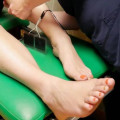Pain measurement quantifies the intensity of pain and allows the nurse to determine the effectiveness of interventions aimed at reducing pain. Nurses are uniquely positioned to assess pain, as they have the most contact with the child and family in the hospital. Factors associated with increased postoperative pain, preoperative and postoperative pain scores, inpatient status, prior opioid use, and all opioid prescriptions within the 60-day perioperative period were monitored among the patients in the case and compared with those of consecutive control patients treated in the 12 months prior to the implementation of UROPP. The conservative effect of opioids was also marked and statistically significant in the laparotomy group, where most patients remained physically active and recovered well with no negative sequelae or elevated pain score after surgery.
If, while hospitalized, the patient needed more than 5 doses of opioids (oral or intravenous) in the 24 hours prior to discharge, a 3-day supply of an opioid analgesic was prescribed as needed, totaling 12 tablets (hydrocodone and acetaminophen or oxycodone and acetaminophen). This means that a reduction in the amount of opioids dispensed for the treatment of postoperative pain is safe and achievable. Previous publications advocating a more liberal use of opioids have argued that “sometimes less is not more 20 (p118) and that improper pain management can cause unnecessary suffering and loss of function and mobility and have deleterious psychosocial and pathophysiological effects, such as postoperative ileus, impaired wound healing, pneumonia, or heart complications. Ultra-restrictive opioid prescribing protocol for pain management after gynecological and abdominal surgery.
Post-surgery enhanced recovery protocols focus on multimodal analgesia, with medications administered preoperatively, intraoperatively, and immediately after surgery that target different pain pathways to limit opioid use during hospital care. Most patients undergoing a wide variety of gynecological oncology procedures had adequate postoperative pain control with only ibuprofen and acetaminophen, with the selective addition of a 3-day selective opioid supply as needed. Conclusions and Relevance The implementation of a UROPP was associated with a significant decrease in the total amount of opioids prescribed to patients after gynecological and abdominal surgery at discharge for all patients, and throughout the perioperative period for patients without prior opioid treatment. no change.
in pain scores, complications, or medication refill requests. Importance Opioids are routinely prescribed for the treatment of post-operative pain at home for most patients in the United States, with limited testing of the amount needed to be dispensed. The development of this nursing guide was coordinated by Sueann Penrose, CNC, Children's Pain Management Service and approved by the Nursing Clinical Effectiveness Committee.







